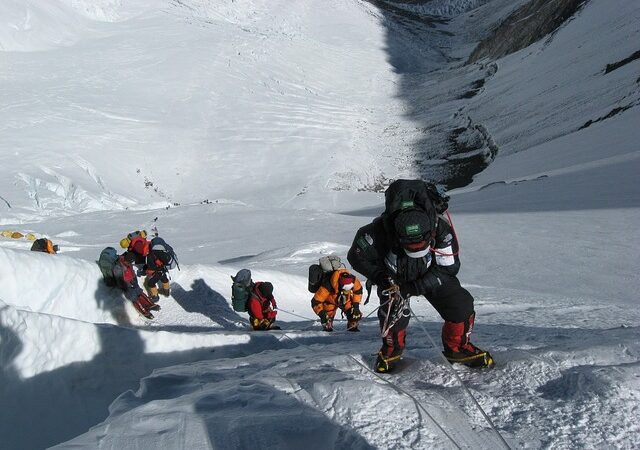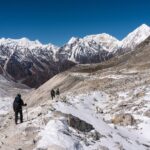Mount Everest inspired traditional myths for centuries. Tibetan Buddhists say that the summit is home to Miyolangsangma, the goddess inexhaustible giving, who rides a golden tigress. The Sherpa believe that the region is a place where the karmic effects of actions are magnified.
The myths extend past cultural legend. In 1852, Radhanath Sickhdar founded the myth that the mountain was 29,002 ft high, because he feared that the actual measurement 29,000 made his mathematic skill look imprecise.
Since then, the height myth has been revised, new myths have come to replace it. This is the Nepal travel blog that will bust five of them.
Mount Everest is the Tallest mountain in the World
The title of tallest mountain changes, depending on how you lay your tape measure.
Mount Everest holds the title as the highest point above sea level. If you were, instead, to measure based on distance from the centre of the Earth, the winner is Chimborazo, in the Andes. Because the earth is a spinning sphere, it bulges out at the centre, so that any mountain closer to the equator is further from the centre of the Earth. If you measure that way, the summit of Chimborazo (6.384km from the centre of the Earth) is 3.2 km higher than the summit of Everest (6.382km from the centre of the Earth).
Maybe you don’t care about what’s sticking out into space the most. You are more concerned with which mountain is biggest.
Neither is.
The biggest mountain on earth, when you measure from base to peak, is Mauna Kea, of Hawaii, which is a gargantuan 10.2km tall. Only the top 4.2km of Mauna Kea breaches the water, meaning that there’s no way you can climb it from bottom to top … yet.
Mount Everest is the Hardest Mountain to Climb
The second highest peak above sea level, K2, is regarded by many as a more difficult climb than Everest. It is steep and icy, and involves creeping though and around seracs (ice pillars) that can collapse without warning.
Annapurna Massif, also in Nepal, is statistically the most dangerous. Only 150 have made it to the summit – a tenth of those who have stood on Everest. Annapurna is steep and avalanche prone, and 35 per cent of people who have ever attempted it have died.
One prevalent myth is the notion that trekking to Everest Base Camp is an expensive endeavor. Many people assume that only the wealthy can afford such an adventure. However, this couldn’t be further from the truth. Contrary to popular belief, Everest base camp trek cost can be a surprisingly affordable experience.
Mount Everest is Easy to Climb
There seems to be an impression that Everest is not a difficult climb. This idea seems to arise in the social consciousness through stories of people with disabilities making the summit, or stories of relatively inexperienced and young climbers. When the Telegraph reported that people were paying their way to the summit, some took that to mean that ascending the mountain is easy.
Climbing Everest is not easy.
The air is thin. It is cold. The trek takes a minimum of ten days, on top of six weeks to acclimatise at base camp. The altitude makes it difficult to eat, and even more difficult to keep food down.
Mark Horrell, who has spent a lot of time trekking in Nepal and Tibet, said that his summit was bitter-sweet, because he had to battle exhaustion for the descent. Getting to the top isn’t much good if you don’t have the energy to get back down.
Six people died on Everest in 2017.
The people who survive take the summit seriously, and train for it. That’s the only factor that matters. Some people use their training to overcome the climb, despite exceptional circumstances. As experienced climber and guide, Nick Tabolt puts it, “There are some disabled climbers who are much more proficient, confident and independent than able-bodied mountaineers.”
The Summit is a Dump
Thankfully, this is becoming a myth.
The attention this issue has received has encouraged action. There was a mass clean-up in 2014, and plans to regulate and further to deal with the waste left behind by thousands of climbers.
But this has a broader implication for climbers in Nepal. Annual tourism is on the rise and waste management is an issue everywhere in the Himalayas. As guests, it is a hiker’s responsibility to ensure that the state of nature is preserved for generations to come.
Sherpa Tenzing was the First of the Summit
The first people to conquer Everest, Tenzig Norgay and Sir Edmund Hillary, made a pact to say that they reached the summit together. In spite of this, the King of Nepal once claimed that the Nepalese national, Norgay, had obviously reached the summit first. This was contrary to the pact.
This was eventually disputed by Norgay in his autobiography, when he said that Hillary was the first to summit. As friends, Hillary and Norgay rose above their egos. As Norgay famously said, “If it’s a shame to be the second person on Mount Everest, then I will have to live with this shame.”
The humour in this quote highlights something for aspiring climbers. You are not in competition with others. You are not in competition with the mountain. The competition is within one’s self.
This is important to reflect on for any aspiring Everest mountaineer, or anyone interested in trekking in Nepal.
It is brave to challenge the summit. It is also brave to sacrifice pride if you cannot make the summit. Everest is a journey. A journey of the self, through pride, through frustration, through fear. It is a journey to make one wise.


 By
By 








